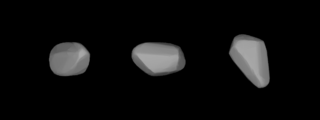Related Research Articles

Lucretia is an asteroid belonging to the Flora family in the Main Belt. It was discovered by Austrain astronomer Johann Palisa on 31 October 1888 in Vienna, and is named after the middle name of Caroline Herschel, one of the first female astronomers. Light curves of this asteroid show a synodic rotation period of 4.349±0.001 h with an amplitude of 0.3–0.4 magnitude. The spin axis appears nearly perpendicular to the ecliptic.

Gisela is an asteroid belonging to the Flora family in the Main Belt that has an unusually high albedo.

Amicitia is a typical Main belt asteroid that is a member of the Flora family. It was discovered by Auguste Charlois on 19 May 1893 in Nice.
Tea is an S-type asteroid belonging to the Flora family in the Main Belt. Its diameter is about 21 km and it has an albedo of 0.183. Its rotation period is 6.4 hours.

Rosamunde is an S-type asteroid belonging to the Flora family in the Main Belt. Its diameter is about 19 km and it has an albedo of 0.243 . Its rotation period is 9.336 hours.
Herodias is a carbonaceous asteroid from the central regions of the asteroid belt, approximately 66 kilometers in diameter. It is an identified Eunomian interloper. It was named after the biblical character Herodias.

685 Hermia is an S-type asteroid belonging to the Flora family in the Main Belt. Its diameter is about 11 km and it has an albedo of 0.281.
700 Auravictrix is an asteroid belonging to the Flora family in the Main Belt. Its diameter is about 15 km and it has an albedo of 0.246. Its rotation period is 6.075 hours.
711 Marmulla is an asteroid belonging to the Flora family in the Main Belt. It was discovered 1 March 1911 by Austrian astronomer Johann Palisa. The asteroid name may be derived from the Old High German word 'marmul', which means 'marble'. This asteroid is orbiting 2.24 AU from the Sun with a period of 3.35 yr and an eccentricity (ovalness) of 0.195. The orbital plane of 711 Marmulla is inclined at an angle of 6.1° to the plane of the ecliptic.

770 Bali is a minor planet orbiting the Sun. It is a member of the Flora family. It was discovered on 31 October 1913, by German astronomer Adam Massinger at the Heidelberg Observatory in southwest Germany. The asteroid was probably named after the Indonesian island of Bali, as the discoverer had named a couple other asteroids after places in Indonesia. The alternative hypothesis is that it was named after Bali, king of the Daityas in Hindu mythology.

800 Kressmannia is an S-type asteroid belonging to the Flora family in the Main Belt. Its rotation period is 4.464 hours.
827 Wolfiana, provisional designation 1916 ZW, is a Florian asteroid from the inner regions of the asteroid belt, approximately 8 kilometers in diameter. It was discovered at Vienna Observatory on 29 August 1916, by Austrian astronomer Johann Palisa, who named it after German astronomer Max Wolf. The assumed stony asteroid has a rotation period of 4.0654 hours.
841 Arabella is an asteroid belonging to the Flora family in the Main Belt. Its rotation period is 3.39 hours. It is named after the title character from Richard Strauss' opera Arabella.
905 Universitas is an S-type asteroid orbiting in the Main belt as part of the Flora family. Its diameter is about 21 km and it has an albedo of 0.085. Its rotation period is approximately 14.2 hours.
960 Birgit is a background asteroid, approximately 8 kilometers in diameter, located in the Florian region of the inner asteroid belt. It was discovered on 1 October 1921, by astronomer Karl Reinmuth at the Heidelberg Observatory in southern Germany. The possibly S-type asteroid has a rotation period of 8.9 hours. It was named after Birgit Asplind, daughter of Swedish astronomer Bror Asplind (1890–1954).
1055 Tynka, provisional designation 1925 WG, is a stony Florian asteroid from the inner regions of the asteroid belt, approximately 10 kilometers in diameter. It was discovered on 17 November 1925, by Czech astronomer Emil Buchar at the Algiers Observatory in North Africa, who named it after his mother Tynka Buchar.
1675 Simonida, provisional designation 1938 FB, is a stony Florian asteroid from the inner regions of the asteroid belt, approximately 11 kilometers in diameter. Discovered by Milorad Protić in 1938, it was later named after the medieval Byzantine princess Simonida.
3953 Perth, provisional designation 1986 VB6, is a stony Florian asteroid from the inner regions of the asteroid belt, approximately 4.5 kilometers (2.8 mi) in diameter. It was discovered on 6 November 1986, by American astronomer Edward Bowell at the Anderson Mesa Station near Flagstaff, Arizona. The asteroid was named for the Australian Perth Observatory.
1523 Pieksämäki, provisional designation 1939 BC, is a stony Florian asteroid from the inner regions of the asteroid belt, approximately 9 kilometers in diameter. It was discovered on 18 January 1939, by Finnish astronomer Yrjö Väisälä at the Turku Observatory in Southwest Finland, and named for the town of Pieksämäki.

1310 Villigera, provisional designation 1932 DB, is a stony asteroid and large Mars-crosser from the innermost regions of the asteroid belt, approximately 14 kilometers in diameter. It was discovered on 28 February 1932, by German astronomer Friedrich Schwassmann at Bergedorf Observatory in Hamburg, Germany. The asteroid was named after astronomer Walther Villiger.
References
- 1 2 3 "428 Monachia (1897 DK)". JPL Small-Body Database . NASA/Jet Propulsion Laboratory . Retrieved 10 May 2016.
- 1 2 Supplemental IRAS Minor Planet Survey Archived June 23, 2006, at archive.today
- 1 2 Kryszczynska, A.; et al. (October 2012). "Do Slivan states exist in the Flora family?. I. Photometric survey of the Flora region". Astronomy & Astrophysics. 546: 51. Bibcode:2012A&A...546A..72K. doi: 10.1051/0004-6361/201219199 . A72.
{{cite journal}}: CS1 maint: postscript (link) - ↑ Lutz D. Schmadel (2011). Dictionary of Minor Planet Names (Addendum to Fifth Edition: 2006–2008 ed.). Springer. ISBN 978-3-642-01966-1.